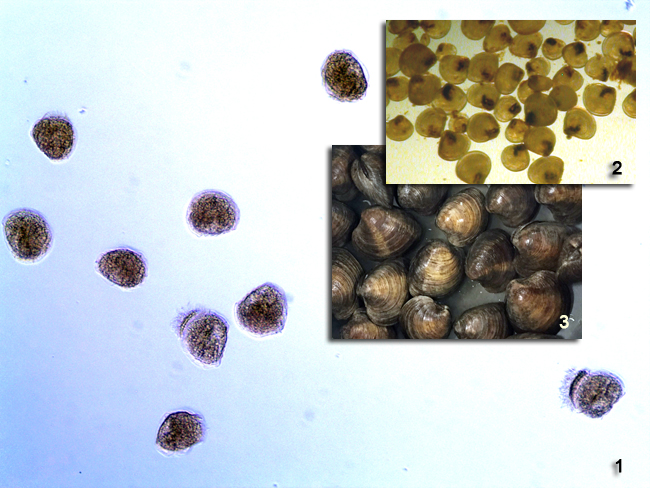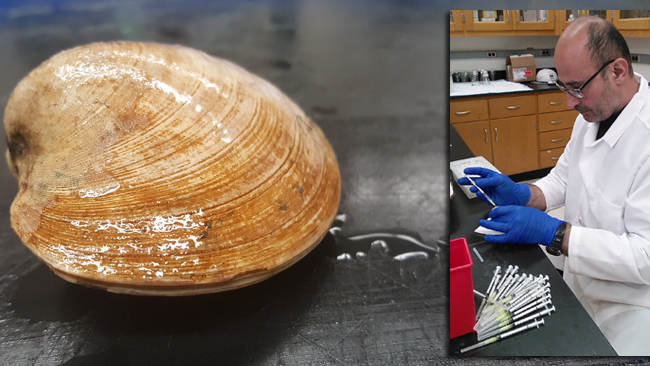
Bassem Allam, a researcher at Stony Brook University (SBU)’s School of Marine and Atmospheric Sciences (SoMAS), examines a number of marine mollusks, including hard clams, seen here in various life cycle stages, including (1) larvae, (2) juvenile and (3) adult. Hard clams typically begin their adult lives as males, but in successive years may change their sex and produce eggs. Credit: Bassem Allam.
— By Chris Gonzales, Freelance Science Writer, New York Sea Grant
Scientists are using RNA sequencing to identify viruses that are associated with marine mollusks
Stony Brook, NY, March 24, 2021 - Little is known about viruses that cohabit with, and infect, marine mollusks. These include ecologically and commercially important species such as oysters, clams, mussels, and scallops.
Umberto Rosani, a biologist at the University of Padua, Italy, and coauthors have published a paper in the journal Viruses putting forward a general view of viruses in this niche, which they term the “bivalve virome.”1
Investigators conducted a detailed exploration of viral abundance and diversity in bivalve mollusks. The study was partially funded by New York Sea Grant (NYSG) in support of Bassem Allam, a project leader and a marine biologist at Stony Brook University (SBU)’s School of Marine and Atmospheric Sciences (SoMAS).
The main aim of the Sea Grant-funded project is to help researchers identify genetic features associated with resilience against ocean acidification, which occurs when excess carbon enters the ocean, leading to overly-acidic conditions and harming aquatic life.
An additional goal of the work—part of the Ocean Acidification Program of the National Oceanic and Atmospheric Administration (NOAA), Sea Grant’s federal parent agency—is to provide the aquaculture industry with tools to select resilient shellfish stocks. Throughout the project, a significant amount of genomic data (e.g. RNA-seq [RNA sequencing] datasets) have been generated, and this paper focuses on exploiting such data for a better understanding of bivalve health.
“Most often, RNA studies focus on understanding the genetic make-up or gene regulation in economically and ecologically important species,” said Allam. “But the produced datasets also contain information on non-target microbes, such as parasites and pathogens, mutualistic microbes, and other symbionts. This information is rarely analyzed.”

Investigator Bassem Allam collects clam blood in the lab. Credit: Emmanuelle Pales Espinosa, SoMAS, SBU.
The researchers analyzed RNA sequences of 58 bivalve species, and were able to identify and reconstruct this genetic code-carrying complex compound for 26 nearly complete and 413 partial virus genomes. They found 96% of these genomes represent previously unidentified—that is, newly discovered—viruses. Some, however, are already known to be associated with bivalves or other marine invertebrates.
“These findings improve our understanding of the kinds of viruses that often inhabit the world of bivalves,” said Allam.
Muddying the Waters
Oceans are in fact rich reservoirs of virus activity. To complicate matters, bivalves may be susceptible to pathogens in different ways depending on circumstances or factors present in the environment. Furthermore, since bivalves are filter-feeders, they tend to accumulate microbes. Meanwhile, viruses can infect almost any living organism. It may be that some of the viral DNA found in bivalves actually originated in another organism common in the marine environment that was consumed by the mollusk.
“Our results show the presence of a broad range of viruses in bivalves, with some of these having a cosmopolitan distribution while others being specific to a particular host and/or region,” said Allam. “Beyond the specific findings of the study, the results indicate that publicly available genomic datasets represent an easily-accessible gold mine for enhancing our understanding of bivalve (and other species) virome diversity and dynamics.”
Overall, this study gives a general overview of the diversity of viruses associated with marine mollusks. It also adds to the library of genetic information that may soon be useful to the aquaculture industry for selecting shellfish resistant in future ocean-acidic conditions.
For more on this project, see the story "Are Shellfish Resilient Against Ocean Acidification?"
Also, there was a second NYSG-funded research project supported in 2016 as part of NOAA’s Ocean Acidification Program. Awarded to Dianna Padilla, the study focused on mussels throughout their life cycles, across multiple generations, to assess their ability to adapt to acidic conditions.
References
1 Rosani, U., et al. A Needle in A Haystack: Tracing Bivalve-Associated Viruses in High-Throughput Transcriptomic Data. Viruses 2019, 11, 205; doi:10.3390/v11030205
Video from "Stopping the Disease that has Wracked the New York Hard Clam Fishery" (December 2018)
More Info: New York Sea Grant
New York Sea Grant (NYSG), a cooperative program of Cornell University
and the State University of New York (SUNY), is one of 34 university-based
programs under the National Oceanic and Atmospheric Administration’s
National Sea Grant College Program.
Since 1971, NYSG has represented a statewide network of integrated
research, education and extension services promoting coastal community
economic vitality, environmental sustainability and citizen awareness
and understanding about the State’s marine and Great Lakes resources.
Through NYSG’s efforts, the combined talents of university scientists
and extension specialists help develop and transfer science-based
information to many coastal user groups—businesses and industries,
federal, state and local government decision-makers and agency managers,
educators, the media and the interested public.
The program maintains Great Lakes offices at Cornell University, SUNY
Buffalo, SUNY Oswego and the Wayne County Cooperative Extension office
in Newark. In the State's marine waters, NYSG has offices at Stony Brook
University in Long Island, Brooklyn College and Cornell Cooperative
Extension in NYC and Kingston in the Hudson Valley.
For updates on Sea Grant activities: www.nyseagrant.org has RSS, Facebook, Twitter, Instagram, and YouTube links. NYSG offers a free e-list sign up via www.nyseagrant.org/nycoastlines for its flagship publication, NY Coastlines/Currents, which is published quarterly.